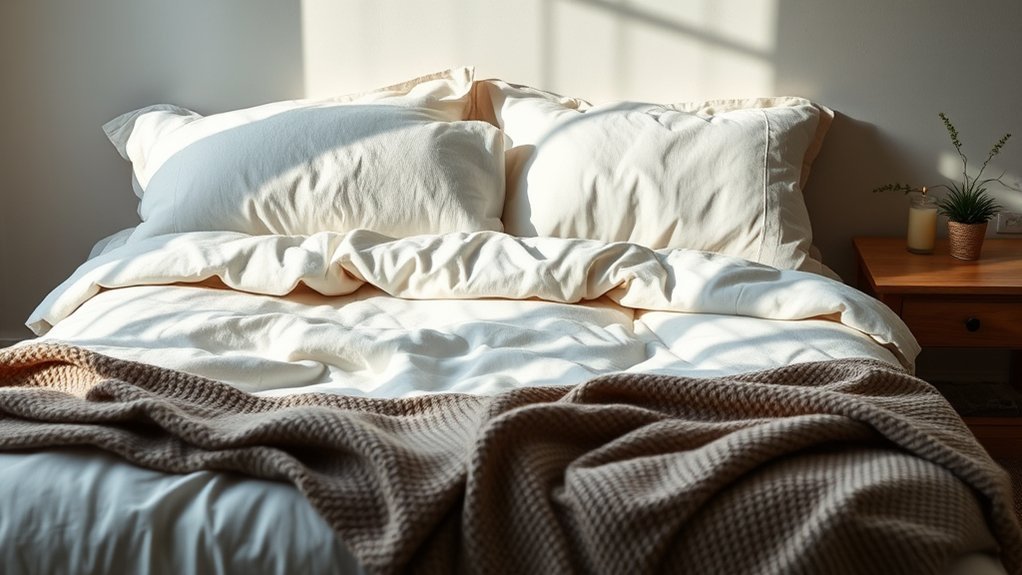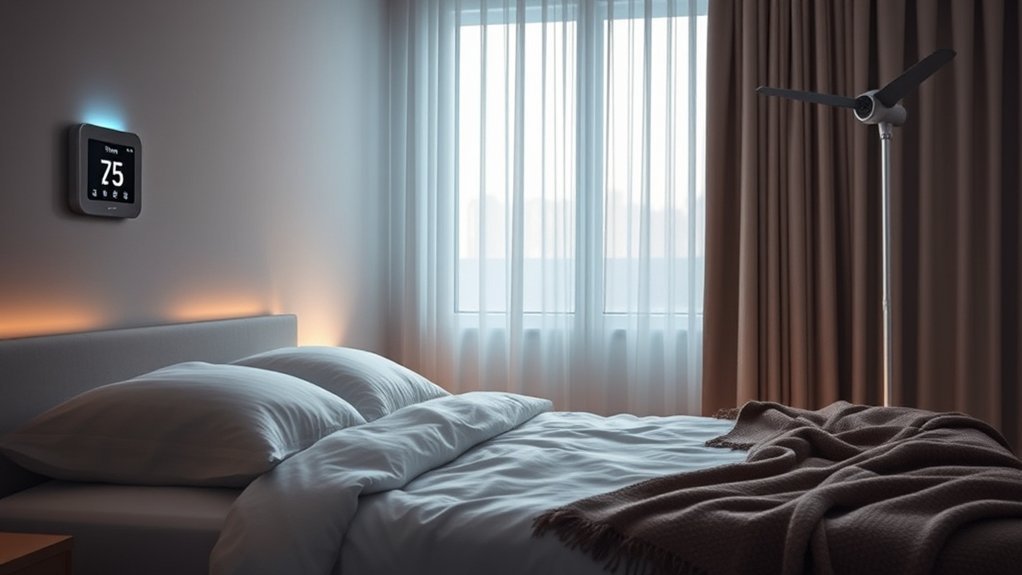Imagine trying to relax on a rocky beach instead of a soft, inviting shore—this is what poor sleep comfort feels like. Your mattress plays a vital role in supporting your body and ensuring restful sleep. But that’s just the beginning; the bedding, room temperature, and even your nighttime routine all contribute to how well you rest. Ready to transform your sleep environment into a sanctuary?
Choosing the Right Mattress

When it comes to getting a good night’s sleep, choosing the right mattress is essential, as the right support can greatly impact your overall comfort and health.
First, consider your sleeping position. If you’re a side sleeper, a softer mattress may alleviate pressure on your shoulders and hips. Back sleepers often benefit from medium-firm options, while stomach sleepers usually need a firmer surface to prevent back strain.
Consider your sleeping position to choose the right mattress: softer for side sleepers, medium-firm for back sleepers, and firmer for stomach sleepers.
Additionally, pay attention to materials. Memory foam provides contouring support, while innerspring mattresses offer bounce and breathability.
Don’t forget to test the mattress in-store; lie down for at least 10 minutes to gauge comfort.
Investing in a high-quality mattress can lead to improved sleep quality and, ultimately, better well-being.
Selecting Comfortable Bedding

Selecting comfortable bedding is essential for enhancing your sleep experience, as the right sheets, pillows, and blankets can greatly affect your overall comfort.
Here are three key factors to evaluate:
- Material: Opt for breathable fabrics like cotton or bamboo. These materials regulate temperature and wick moisture, promoting a cooler sleep environment.
- Thread Count: Look for sheets with a thread count between 300-600. This range offers a balance of softness and durability, ensuring a cozy feel without sacrificing longevity.
- Pillow Support: Choose a pillow that aligns with your sleeping position. For instance, side sleepers benefit from firmer, thicker pillows, while back sleepers may prefer medium support for proper neck alignment.
Investing in quality bedding can make a significant difference in your sleep quality.
Controlling Room Temperature

To achieve ideal sleep, controlling your room temperature is essential, as a comfortable environment can greatly enhance your rest.
Research shows that the best bedroom temperature for sleep is between 60 to 67 degrees Fahrenheit (15 to 19 degrees Celsius). At this temperature range, your body can naturally lower its core temperature, promoting deeper sleep cycles.
If your room’s too hot, it can lead to restless nights and frequent awakenings. Conversely, a room that’s too cold might cause discomfort and disrupt your sleep.
Use fans, air conditioning, or heating to maintain this range, and consider breathable bedding materials to help regulate your body temperature.
Minimizing Noise Disruptions
Although it’s often overlooked, minimizing noise disruptions is essential for achieving a restful night’s sleep.
Research shows that exposure to noise can greatly impact your sleep quality, leading to fatigue and irritability.
Here are three effective strategies to reduce noise disturbances:
- Use White Noise Machines: These devices create a consistent sound environment that masks disruptive noises, helping you stay asleep longer.
- Seal Windows and Doors: Caulking gaps and using weatherstripping can block outside noise, creating a quieter sleeping space.
- Invest in Soundproofing Materials: Acoustic panels or heavy curtains can absorb sound and minimize disturbances, allowing for a more peaceful environment.
Establishing a Relaxing Bedtime Routine
Creating a relaxing bedtime routine can greatly enhance your sleep quality, as it signals your body that it’s time to wind down. Start by setting a consistent bedtime, ideally the same time every night. Engage in calming activities like reading, gentle stretching, or meditation. Avoid screens to minimize blue light exposure, which can interfere with melatonin production.
Here’s a simple table to help you establish your routine:
| Activity | Duration |
|---|---|
| Dim the lights | 10 minutes |
| Read a book | 20 minutes |
| Stretch or meditate | 15 minutes |
| Journaling | 10 minutes |
| Prepare for sleep | 5 minutes |
Frequently Asked Questions
How Does Diet Affect Sleep Comfort and Quality?
Your diet greatly impacts sleep quality. Consuming heavy meals, caffeine, or alcohol close to bedtime can disrupt your rest. Instead, focus on balanced meals and sleep-friendly foods to enhance your comfort and overall sleep experience.
Can Exercise Improve Sleep Comfort and Reduce Insomnia?
Exercise acts like a soothing lullaby for your body, easing tension and promoting deeper sleep. It reduces insomnia by balancing hormones and boosting mood, making you drift off more easily into peaceful slumber.
What Are the Effects of Screen Time on Sleep?
Excessive screen time disrupts your sleep by inhibiting melatonin production, making it harder for you to fall asleep. Blue light exposure from screens can also interfere with your sleep quality, leaving you feeling less rested.
How Can Stress Management Techniques Enhance Sleep Comfort?
Stress management techniques, like mindfulness and deep breathing, help you relax, reduce anxiety, and lower cortisol levels. By incorporating these practices into your routine, you’ll likely experience improved sleep quality and overall comfort during rest.
Are There Specific Scents That Promote Better Sleep Quality?
Yes, specific scents like lavender, chamomile, and sandalwood can promote better sleep quality. They’ve been shown to reduce anxiety and enhance relaxation, helping you drift off into a peaceful slumber more easily.
Conclusion
In your quest for sleep paradise, remember that a well-chosen mattress and cozy bedding can work wonders for your slumber. By curating a tranquil environment with ideal temperatures and soothing sounds, you can gently guide your body into restful nights. Embrace a calming bedtime routine, free from digital distractions, to signal your mind that it’s time to unwind. With these simple adjustments, you’ll be on your way to experiencing the sweet embrace of rejuvenating sleep.
